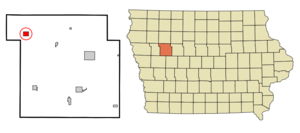- Schaller, Iowa
Infobox Settlement
official_name = Schaller, Iowa
settlement_type =City
nickname =
motto =
imagesize =
image_caption =
image_
imagesize =
image_caption =
image_
mapsize = 250x200px
map_caption = Location of Schaller, Iowa
mapsize1 =
map_caption1 =subdivision_type = Country
subdivision_name =
subdivision_type1 = State
subdivision_name1 =
subdivision_type2 = County
subdivision_name2 = Sac
government_footnotes =
government_type =
leader_title =
leader_name =
leader_title1 =
leader_name1 =
established_title =
established_date =unit_pref = Imperial
area_footnotes =area_magnitude =
area_total_km2 = 3.3
area_land_km2 = 3.3
area_water_km2 = 0.0
area_total_sq_mi = 1.3
area_land_sq_mi = 1.3
area_water_sq_mi = 0.0population_as_of = 2000
population_footnotes =
population_total = 779
population_density_km2 = 239.2
population_density_sq_mi = 619.4timezone = Central (CST)
utc_offset = -6
timezone_DST = CDT
utc_offset_DST = -5
elevation_footnotes =
elevation_m = 430
elevation_ft = 1411
latd = 42 |latm = 29 |lats = 50 |latNS = N
longd = 95 |longm = 17 |longs = 39 |longEW = Wpostal_code_type =
ZIP code
postal_code = 51053
area_code = 712
blank_name = FIPS code
blank_info = 19-71085
blank1_name = GNIS feature ID
blank1_info = 0465956
website =
footnotes =Schaller is a city in Sac County,
Iowa ,United States . The population was 779 at the 2000 census.History
The town of Schaller, named after Phil Schaller, was incorporated in 1882. The town had been founded in August 1879 as a station for the railroad under construction. The economy then, as currently, was based on commercial support for surrounding farms. Settlers came mostly from Germany, England, Canada, New York, and eastern Iowa. Throughout the middle part of the twentieth century a major industry consisted of the packers of Bango and Jolly Time
popcorn . The presence and size of these two companies encouraged the townspeople to call Schaller "The Popcorn Capital of the world." Popcorn is still a major area crop but the companies moved on to other locations in the 1980s. The railroad ceased operations and pulled up tracks in the 1970s. Transportation connections are byU.S. Route 20 andIowa Highway 110 . Corn (seed and feed), soy beans, and feeder cattle are the major products of the area.Geography
Schaller is located at coor dms|42|29|50|N|95|17|39|W|city (42.497325, -95.294219)GR|1.
According to the
United States Census Bureau , the city has a total area of 1.3square mile s (3.3km² ), all of it land.Demographics
As of the
census GR|2 of 2000, there were 779 people, 321 households, and 216 families residing in the city. Thepopulation density was 619.4 people per square mile (238.7/km²). There were 347 housing units at an average density of 275.9/sq mi (106.3/km²). The racial makeup of the city was 97.82% White, 0.13% African American, 0.26% Native American, 0.26% Asian, 0.13% Pacific Islander, 0.64% from other races, and 0.77% from two or more races. Hispanic or Latino of any race were 3.08% of the population.There were 321 households out of which 30.2% had children under the age of 18 living with them, 54.8% were married couples living together, 9.3% had a female householder with no husband present, and 32.4% were non-families. 28.7% of all households were made up of individuals and 14.0% had someone living alone who was 65 years of age or older. The average household size was 2.43 and the average family size was 2.97.
In the city the population was spread out with 27.1% under the age of 18, 9.1% from 18 to 24, 23.6% from 25 to 44, 20.4% from 45 to 64, and 19.8% who were 65 years of age or older. The median age was 38 years. For every 100 females there were 100.3 males. For every 100 females age 18 and over, there were 93.9 males.
The median income for a household in the city was $33,365, and the median income for a family was $40,268. Males had a median income of $26,964 versus $17,875 for females. The
per capita income for the city was $15,520. About 2.6% of families and 5.0% of the population were below thepoverty line , including 3.2% of those under age 18 and 5.1% of those age 65 or over.References
External links
Wikimedia Foundation. 2010.


